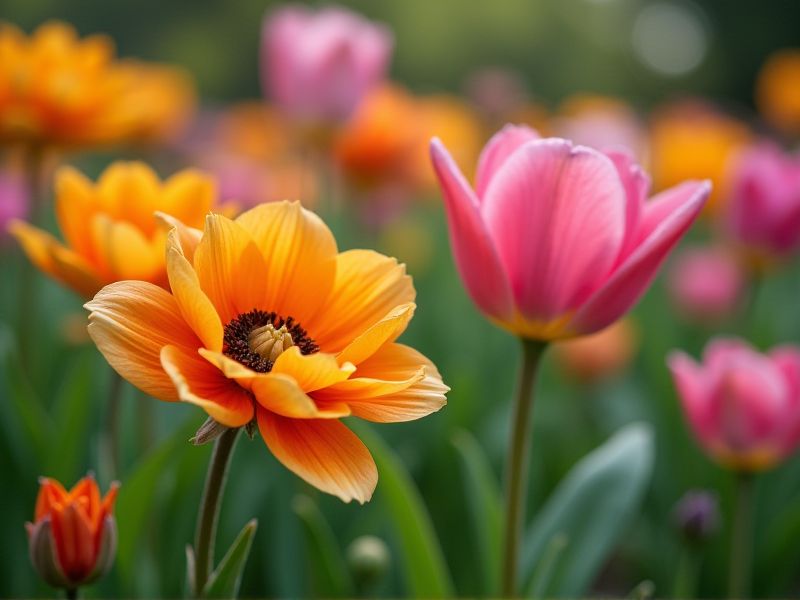
Spring-blooming bedding plants are essential for vibrant outdoor spaces, offering a burst of color after the winter months. Popular choices include pansies, which thrive in cooler temperatures and display a wide range of hues, and petunias, known for their fragrant flowers and ability to withstand various weather conditions. Snapdragons add vertical interest with their tall spikes and charming, dragon-shaped blooms, while marigolds provide both beauty and pest-repelling properties, making them practical additions to the garden. Consider adding geraniums for their long-lasting blossoms and versatility in containers or garden borders. To ensure a striking display, select a mix of these plants to create a layered and visually appealing landscape.
List of some Bedding plants that bloom in spring
- Pansy (Viola × wittrockiana)
- Snapdragon (Antirrhinum majus)
- Primrose (Primula vulgaris)
- Sweet Alyssum (Lobularia maritima)
- Calendula (Calendula officinalis)
- Marigold (Tagetes patula)
- Petunia (Petunia × atkinsiana)
- Forget-Me-Not (Myosotis sylvatica)
- Lobelia (Lobelia erinus)
- Dianthus (Dianthus chinensis)
Important things about Bedding plants that bloom in spring
Popular Spring Bedding Plants
Spring bedding plants offer a vibrant array of colors and textures to enhance your garden. Marigolds, with their bright yellows and oranges, are excellent for borders while providing pest control benefits. Petunias bring a cascading effect and are available in various shades, making them ideal for hanging baskets and containers. Consider planting pansies for their ability to withstand cooler temperatures, providing early-season blooms that can last until summer.
Ideal Planting Conditions
Bedding plants that bloom in spring thrive in well-drained soil enriched with organic matter, which promotes healthy root development. Your bedding area should receive at least six hours of sunlight daily, ensuring that flowers like petunias, marigolds, and snapdragons achieve optimal growth and vibrant blooms. Regular watering is crucial, especially during dry spells, but avoid waterlogged conditions that can lead to root rot. Fertilizing your bedding plants with a balanced, slow-release fertilizer can enhance blooming and overall health throughout the season.
Soil Requirements
Bedding plants that bloom in spring thrive in well-drained soil enriched with organic matter, promoting healthy root development and vibrant blooms. A pH level between 6.0 and 6.8 is ideal for most spring bloomers, including petunias, marigolds, and snapdragons. When preparing your garden bed, incorporate compost or aged manure to improve soil structure and nutrient availability. Regularly testing your soil can help you adjust amendments for optimal growth during the crucial blooming season.
Watering Needs
Bedding plants that bloom in spring, such as petunias and marigolds, require consistent watering to thrive. It's essential to keep the soil moderately moist, avoiding both overwatering and drought stress, as these conditions can hinder growth and flowering. During warmer months, your bedding plants may need daily watering, particularly in containers where moisture evaporates quickly. Regular monitoring of the soil's moisture level will ensure that your spring blooms remain vibrant and healthy throughout the season.
Sunlight Exposure
Bedding plants that bloom in spring, such as petunias, marigolds, and pansies, thrive in sunlight for optimal growth and vibrant flower display. These plants typically require at least six hours of direct sunlight each day, making them perfect for bright garden spots or colorful patio containers. When selecting your bedding plants, consider their sunlight needs to ensure they flourish and produce abundant blooms throughout the season. Proper sunlight exposure not only enhances the visual appeal of your garden but also encourages healthy foliage and strong blooms.
Fertilization Tips
To ensure your bedding plants bloom vibrantly in spring, consider using a balanced fertilizer with an equal ratio of nitrogen, phosphorus, and potassium (NPK), such as a 10-10-10 formula. Incorporate organic matter like compost into your soil to improve drainage and nutrient retention, fostering healthier root systems. Regularly apply a slow-release fertilizer every 4 to 6 weeks to provide consistent nourishment throughout the growing season. Keep an eye on your plants for signs of nutrient deficiency, such as yellowing leaves, which may indicate the need for additional fertilization.
Pest And Disease Management
Bedding plants that bloom in spring, such as pansies, petunias, and begonias, can enhance your garden with vibrant colors while also attracting pollinators. However, they are susceptible to pests like aphids and diseases such as powdery mildew, which can hinder their growth and flowering. Implementing integrated pest management strategies, such as introducing beneficial insects and utilizing organic fungicides, can effectively protect your plants. Regularly inspecting your bedding plants for early signs of infestation will ensure a flourishing spring display and prolong their blooming period.
Seasonal Maintenance
Spring-blooming bedding plants, such as pansies, petunias, and snapdragons, add vibrant colors to gardens and landscapes. To ensure their health and promote abundant blooms, perform seasonal maintenance tasks including regular deadheading and appropriate watering. You should also consider soil quality; amending with compost can enhance nutrient levels, encouraging robust growth. Finally, providing adequate sunlight and protection from frost is essential for these plants to thrive throughout the blooming season.
Companion Planting Benefits
Companion planting uses the natural properties of different plant species to enhance growth, health, and productivity. When selecting bedding plants that bloom in spring, consider pairing marigolds with vegetables like tomatoes, as marigolds repel harmful pests while attracting beneficial insects. Incorporating herbs such as basil or cilantro alongside your spring bloomers can improve flavor and deter aphids. By thoughtfully designing your garden with compatible species, you can create a vibrant landscape that not only provides aesthetic appeal but also encourages a healthy ecosystem.
Harvesting And Deadheading Techniques
Deadheading bedding plants that bloom in spring is essential for promoting new growth and extending the flowering period. By removing spent flowers, you encourage the plant to divert energy towards producing fresh blooms instead of seed production. Harvesting is equally important, particularly for plants like pansies and petunias, which benefit from regular trimming to maintain a compact shape and vibrant color. Ensure your tools are clean and sharp to prevent any damage to the plant during both processes, promoting overall health and fullness in your spring garden.
